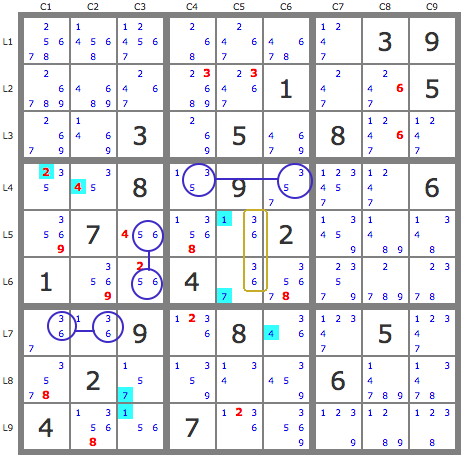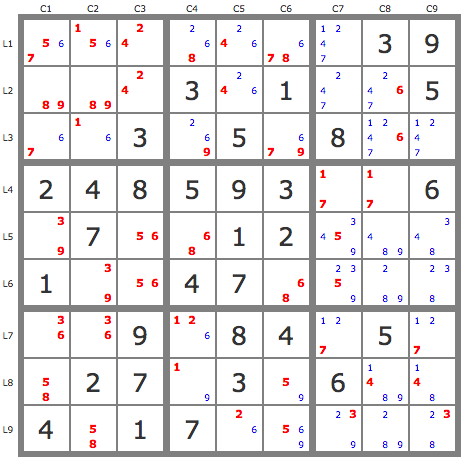Hi Robert,
Just a few quick comments for now:
Mauriès Robert wrote:I looked as closely as I could at SpAce's article on GEM and I think I understood how it works. If GEM and TDP do the same thing because they are techniques that operate two networks, one of which is true and the other is false, but in practice they are different approaches on several points:
I agree that they have several differences, but not necessarily the ones you listed.
1) TDP only uses basic techniques (TB), while GEM uses advanced techniques.
GEM doesn't mandate or restrict the use of any techniques. It's just a coloring framework that supports using as simple or as complex nodes as you want. Obviously skilled players can do more with GEM because they can see more easily advanced patterns that can be used to extend the coloring. One is still free to use basic techniques only, but obviously the coloring can't advance as much with them. It just means that you need to either use a different seed or nested coloring earlier -- just like with TDP.
Where in my GEM demo did I use more advanced techniques than you? I remember only one place and it was the UR I used to extend the coloring. The nice thing about GEM is that such patterns become visible once you get used to the coloring. I don't think there's any way that UR could have been spotted with the simpler TDP coloring. I don't think many of the locked sets or grouped nodes could have been either. So, I think it's more correct to say that GEM makes it much easier to use advanced (or even basic) techniques within the coloring, but it doesn't require it any more than TDP.
This explains why TDP considers disability research as a technique.
Could be, but I think it's more of a philosophical difference too. I'll get back to this later, when I find time to answer your earlier comments about T&E. Anyway, there's nothing in GEM that prevents using it to look for direct contradictions if one wishes. It's just not much fun.
2) TDP does not use sub-colours to distinguish between weak and strong links, nor does it use these concepts,
That's misleading. Of course it uses those concepts even if doesn't state it explicitly. All the singles in your P(E) sets are there because of following alternating weak and strong links from the starting candidates. Similarly, all your contradictions are found following those links as well. How else do they happen? By magic?
GEM just makes all of that explicit, which in turn makes it much easier to follow the coloring and the reasoning behind any eliminations or contradictions found. That's why any deductions found via GEM are also possible to trace and write as AICs or nets. TDP hides all those details, which makes it seem simpler, but it actually makes the deductions much harder to spot and to understand.
As a result, one clear weakness of TDP seems to be that it lacks a way to document the solution steps in a way that's easily followed without doing it yourself or running it through a software solver. For example, I don't really understand your solution
here. All the other solutions are easily verified just by looking at the grid and the provided AIC or fish.
whereas GEM builds the network of strong links on which everything is based.
This is not a real difference either, if you refer to the initial par cluster. You could use GEM just like TDP without building it. In that case only the starting pair would be special -- just like it's in TDP (because you have to know where you started). All the other "singles" would be super-candidates. GEM would still work without the par-candidates but it would be weaker. Btw, this is exactly how GEM is used if the seeding pair is not conjugate (i.e. they have an OR relationship instead of XOR). In that case there are no initial par candidates at all. (Similarly, coloring the sub-candidates can be skipped as well. With just a starting pair and super-candidates GEM would be exactly the same as the TDP coloring.)
3) TDP is less cumbersome to handle
That is a matter of opinion. Obviously I see it the other way around. I don't find GEM cumbersome at all, because it visualizes everything very clearly once you get used to it. The coloring is straight-forward and less error-prone to build manually, for example because the sub-candidates make it much easier to see where the next super-candidates will be. In TDP it's a lot harder to place all those singles in each branch, and I don't know how you could see any group links and locked sets and stuff at all. If I tried to do that manually I'd probably miss a lot of things that are obvious with GEM. The only viable way to use TDP, at least for me, would be to let a computer generate those branches.
since only TB is used and it has been designed for sudokists who have difficulty with advanced techniques.
There's nothing in GEM that prevents it from being used like TDP and with any technique sets one wishes. As far as I see, it's a superset of TDP coloring, so if you strip out enough features (mainly the par- and sub-candidates) it becomes TDP coloring. Maybe such apparent simplicity works better for some people, but I know it wouldn't work for me.
I have just posted part 4 of TDP and I remain at your disposal to discuss.
Thanks, I'll get back to that. At a first glance it kind of looks like the nested coloring I did at the end of the GEM demonstration. Btw, you've missed a hidden triple/naked quad in box 7.



